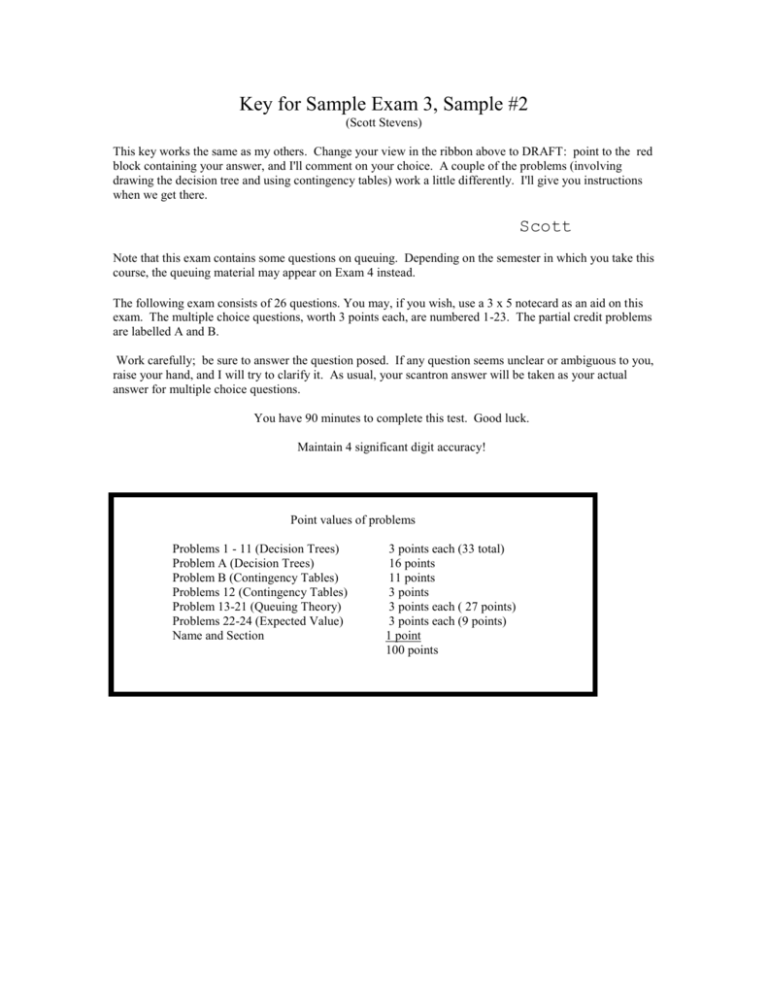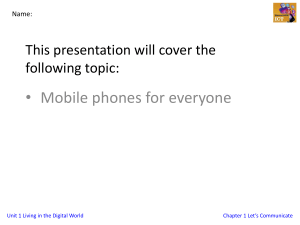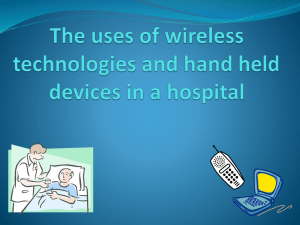Sample Exam #2
advertisement

Key for Sample Exam 3, Sample #2 (Scott Stevens) This key works the same as my others. Change your view in the ribbon above to DRAFT: point to the red block containing your answer, and I'll comment on your choice. A couple of the problems (involving drawing the decision tree and using contingency tables) work a little differently. I'll give you instructions when we get there. Scott Note that this exam contains some questions on queuing. Depending on the semester in which you take this course, the queuing material may appear on Exam 4 instead. The following exam consists of 26 questions. You may, if you wish, use a 3 x 5 notecard as an aid on this exam. The multiple choice questions, worth 3 points each, are numbered 1-23. The partial credit problems are labelled A and B. Work carefully; be sure to answer the question posed. If any question seems unclear or ambiguous to you, raise your hand, and I will try to clarify it. As usual, your scantron answer will be taken as your actual answer for multiple choice questions. You have 90 minutes to complete this test. Good luck. Maintain 4 significant digit accuracy! Point values of problems Problems 1 - 11 (Decision Trees) Problem A (Decision Trees) Problem B (Contingency Tables) Problems 12 (Contingency Tables) Problem 13-21 (Queuing Theory) Problems 22-24 (Expected Value) Name and Section 3 points each (33 total) 16 points 11 points 3 points 3 points each ( 27 points) 3 points each (9 points) 1 point 100 points Questions 1-10 deal with the scenario described below. You are going to leave work on your lunch hour to return an unwanted birthday present to ValuMart, where it was bought. ValuMart has two different stores in your area, Store A and Store B, and you may return your gift to either store. Your goal is to minimize the total (expected) time required to return to work. Store A is five minutes from your place of work. Supposing you go there, the following statistics apply. Upon your arrival, there is a 30% chance that there will be no customers at the Return Desk, a 40% chance that there will be one customer at the Return Desk, and a 30% chance that there will be two customers at the Return Desk. Assume that your total time at the Return Desk will be six minutes for each customer, including yourself. (By the way, this assumption is consistent with an assumption of exponential service time for the customers at the Return Desk.) Store B is seven minutes from your place of work. Supposing you go there, the following statistics apply. Upon your arrival, there is a 60% chance that there will be no customers at the Return Desk, and a 40% chance that there will be one customer already at the Return Desk. Again, assume that your total time at the return desk will be six minutes for each customer, including yourself. You have the option, if you wish, of checking the line situation at Store A (where the Return Desk is visible from the parking lot) and then driving onto Store B. A simple analysis of the situation will make it clear that this option is only worth consideration if the line at Store A is already two people long. This is because it takes five minutes to drive from Store A to Store B. Assume that driving time and time waiting and being served at the Return Desk are the only times which need to be considered in the problem. Remember that you must return to work! Assume that you’ll return to work by the most direct route. An abridged decision tree solution for this problem appears below. All payoffs are in minutes. Complete it by identifying what belongs in the slots marked #1 through #6b, then answer the questions below. Note that, in those questions, if an answer refers to “#1”, it means the number that belongs in slot #1, and so on. CHANGE VIEW TO PRINT LAYOUT TO SEE THE TREE, THEN CHANGE IT BACK TO DRAFT! 16 no #2 a rriv l (.3 ) to St or e A 1 customer ahead of you (.4) 2 cu st o m ers ahe ad of y ou (.3) 25.4 go #1 u line a pon 22 25.4 go to B 1 customer ahead of you (.4) #5 go 28 to e or St B 22.4 no line upon arrival #6a) ( one customer ahead of you #6b) ( 20 26 no one in line upon arrival (.6) #3 #4 1. The value which belongs in location #1 is a) 22.4 b) the same as #2 c) (22.4 + [#2])/2 2. 3. 4. The value which belongs in location #2 is a) 16 b) 21.22c) 22 d) 0 e) the larger of 22.4 and #2 d) 22.51e) 25.4 The value which belongs in location #3 is a) 14 b) 16 c) 18 d) 20 e) 23 The value which belongs in #4 is a) #3 b) 3 + #3 d) 0.6 #3 e) (4 #3)/6 c) 6 + #3 5. Which label would be most appropriate for the branch labelled #5? a) return to work immediately b) stay at Store A c) two customers are ahead of you at B d) return to Store A e) go directly from work to B 6. The probabilities indicated by #6a and #6b are a) 0.3 and 0.4 b) 0.5 and 0.5 c) 0.6 and 0.4 d) 1.0 and 0.0 e) 20 and 26 7. The tree shows a blockade on the “go to Store B” branch. How many other blockades should be drawn on the completed tree? a) 0b) 1 c) 2 d) 4 e) 5 8. The optimal strategy shown on the tree is a) Go to Store A. Be the first one in line. b) Go to Store A. Two customers are in front of you. Go to Store B. One person is in front of you. c) Go to Store A and stay there. d) Go to Store B. e) Go to Store A. If two people are already there, go to Store B. 9. The EVPI for this problem is 1.5 minutes. This means a) Checking Store A before (perhaps) going to Store B saves you an average of 1.5 minutes. b) Checking Store A before (perhaps) going to Store B costs you an average of an additional 1.5 minutes. c) Going directly to Store A and staying there is, on average, 1.5 minutes faster than going directly to Store B. d) Knowing how long the line would be at Store A (before starting your drive) would save you an average of 1.5 minutes on your total time. e) Knowing how long the lines would be at both stores (before starting your drive) would save you an average of 1.5 minutes. 10. The value in slot #1 would tell you a) the number of minutes it will take to return the gift to ValuMart and then return to work. b) the most likely number of minutes it will take to return the gift and then return to work. c) the mean number of minutes you’ll spend in the car while returning the gift. d) the mean number of minutes you’ll spend waiting in line (and being served) at either store. e) none of the above is a correct interpretation of #1. A. (16 points) You have agreed to play a game of Black Death with a friend of yours. You each begin by putting $6 into the “kitty”. (The “kitty” is simply the pile of money which players have contributed to the game.) Black Death is played with a deck of three playing cards, which are shuffled and placed face down on the table. Two of the cards have red faces, and one has a black face. Drawing a red card has no effect on a player, but the black card is the “death card”, and a player who draws it immediately loses the game. You begin play, and thereafter you and your friend alternate turns. Whenever it is your turn, you have two options. You may either i) draw the top card of the stack, or ii) put an additional $10 in the kitty and skip your turn. In either case, your turn is over, and it is your opponent’s turn. On his or her turn, your opponent has no choice. He or she must draw the top card of the stack. The game continues in this fashion until either i) some player has lost by drawing the black card, or ii) the two red cards have both been drawn from the stack. If someone has drawn the black card and thus lost, the other player receives all of the money in the kitty. If the two red cards have been drawn from the stack but neither player has lost, the game is declared a tie, and the kitty is divided evenly between the two players. Note that, since drawn cards are not replaced, the game must be over in no more than two rounds. Draw the decision tree for your play of Black Death, assuming that your goal is to maximize your expected winnings. Include payoffs, branch labels, and probabilities. You need not roll back your tree. (Note: For purposes of this key, I rolled back the tree and stated the optimal strategy and expected optimal payoff. I'd suggest you do the same.) 3 0 2/3 w dra d raw re yo u d ) 3 / 2 ( yo u dr a w (1/3 black ) opponent draw black op po ne nt dr a ws 6 red 0 -6 pa -2 y To see my answer, DELETE key your keyboard. $1 click on the BORDER of this rectangle and hit the -10.5 you on draw black (0.5) t 0 n e n 2/3 letters (If you deleted only some this message, you clicked INSIDE the rectangle. Try again.) -16 dr aw oppofrom d re draw s /3 (2 ) opp one nt d ra (1/3 ws bla ck ) pa ya no you draw red (0.5) the r$ 10 -2 opponent draw s black (0.5) -5 6 6 opponent draw s red (0.5) -10 Optimal strategy: Always pay $10, rather than draw. On average, you'll make 66.67 cents. 11. If you follow the optimal strategy for Black Death, you’ll make an average of 66.67 cents per game. If you sneaked a peek at the top card of the stack before play begins, this jumps to $4 per game. (Note: For extra practice on this sample exam, you may wish to construct this new tree and verify this statement.) The most you can make in Black Death is $6/game, and the most you can lose is $16/game. Using this information, we can compute the EVSI for the information of knowing the top card of the stack before play begins. It is about a) 67 cents/game b) $1.33/game c) $2/game d) $3.33/game e) $4/game B. (11 pts.) 90% of the students who come to class regularly pass the exam, while only 50% of those students who do not come to class regularly manage to pass. 72% of all students both come to class regularly and pass the exam. Given this information, use contingency tables below to determine how likely it is that a student who fails the exam attended class regularly. The letters in the corners of the squares are used for question #12. . (To see my answer in Word, drag your cursor to highlight the whole table, then click on the FONT COLOR button (The "A" with the colored bar under it) on the toolbar. If you’re in your browser but not in Word, you can do this same thing by highlighting the table, then choosing Format/Font/Font Color/Automatic on the menu bar.) Don’t Attend Attend Attend Don’t Attend a b d Pass Test 0.72 0.1 c 0.82 Pass Test 0.72/.82 = 0.8780 0.1/0.82 = 0.1220 Fail Test 0.08 0.1 0.18 Fail Test 0.08/0.18= 0.4444 0.1/0.18= 0.5556 0.8 0.2 P(Row and Column) Attend P(Column | Row) Don’t Attend e Pass Test Fail Test 0.9 0.5 Probability that a student who failed the exam attended class regularly = 0.1 0.5 0.4444 P(Row | Column) Note: Original info in bold. Italicized values not needed. 12. The cell which would tell us what fraction of students passed the test is a) a b) b c) c d) d e) e Questions 13-20 deal with the scenario below. This is a queuing theory question, which is not part of the Summer 12 Exam 3 material! A large hotel has a courtesy phone in the lobby, to allow guests or visitors in the lobby to call directly to the rooms of the hotel guests. This phone is most heavily used in the early morning, between the hours 7 and 9 AM. During this time, people wishing to use the phone ("callers") arrive at a mean rate of 1 person per 40 seconds. Arrivals are Poisson distributed. The duration of the phone calls is exponentially distributed with a mean of 1 minute. Since callers are arriving faster than calls are completed, the management has seen long lines grow at the courtesy phone, which is a considerable annoyance to the callers. For this reason, the management has decided to install additional courtesy phones. To determine how many they should install, they conduct a queuing analysis of the system, considering the possibilities of having a total of 2-6 courtesy phones. It will be assumed throughout that callers will wait until a phone becomes available. The results of the analysis are shown on the next page. All times are in minutes. The tc row represents the total cost per minute of the system operation, assuming that phones cost 5 cents a minute to operate and maintain, and that customer waiting time is worth 20 cents a minute. 2 phones 3 phones 4 phones 5 phones 6 phones P(0) P(1) P(2) P(3) P(4) P(5) P(6) P(7) P(8) P(9) Pw 0.1429 0.2143 0.1607 0.1205 0.0904 0.0678 0.0509 0.0381 0.0286 0.0215 0.6429 0.2105 0.3158 0.2368 0.1184 0.0592 0.0296 0.0148 0.0074 0.0037 0.0019 0.2368 0.2210 0.3315 0.2486 0.1243 0.0466 0.0175 0.0066 0.0025 0.0009 0.0003 0.0746 0.2228 0.3342 0.2506 0.1253 0.0470 0.0141 0.0042 0.0013 0.0004 0.0001 0.0201 0.2231 0.3346 0.2510 0.1255 0.0471 0.0141 0.0035 0.0009 0.0002 0.0001 0.0047 Lq L Wq W 1.9286 3.4286 1.2857 2.2857 0.2368 1.7368 0.1579 1.1579 0.0448 1.5448 0.0298 1.0298 0.0086 1.5086 0.0058 1.0058 0.0016 1.5016 0.0010 1.0010 tc 0.2714 0.2368 0.2772 0.3254 0.3751 13. The hotel management wants the average number of people waiting for a phone to be at most 1. What is the minimum number of phones needed to accomplish this? a) 2 b) 3 c) 4 d) 5 e) 6 14. The hotel management wants the average time that a caller waits for a phone to be no more than 15 seconds. What is the minimum number of phones needed to accomplish this? a) 2 b) 3 c) 4 d) 5 e) 6 15. The hotel management wants at least 85% of its callers to have access to a phone without waiting. What is the minimum number of phones needed to accomplish this? a) 2 b) 3 c) 4 d) 5 e) 6 16. Having three phones gives the lowest value of total operations cost, as defined in the problem. Assume the customer waiting cost remains fixed at 20 cents a minute. If the cost of maintaining and operating a phone in the lobby dropped from 5 cents a minute to 1cent a minute, the number of phones that would minimize total operations cost would now be a) 2 b) 3 c) 4 d) 5 e) 6 17. The hotel management would like to meet this condition: When a newly arrived customer does have to wait, they are usually the only person waiting for a phone at that time. (We take "usually" in thie problem to mean MORE than half of the time, and assume that the numbers given in the table are exact.) What is the minimum number of phones needed to accomplish this? a) 2 b) 3 c) 4 d) 5 e) 6 18. The value of lambda for this problem is a) 40 b) 1.5 c) 1 d) 2/3 e) .025 19 In this problem, the value of k would represent a) the number of phones in the lobby. b) the number of phones in use at a given time. c) the maximum number of people who can be waiting for phones. d) the number of people either using a phone or waiting for one. e) the number of minutes, on average, a person spends on the phone. 20. Assume, as stated in the problem, that service times are exponentially distributed with a mean of one minute. Suppose you’ve been watching a man on one of the phones, and he’s been talking for 30 seconds so far. On average, how much longer will he remain on the phone before hanging up? a) 30 seconds b) 45 seconds c) 60 seconds d) 90 seconds e) the information given does not allow us to answer the question. 21. If = 30, = 5, and k = 3, then (/)k/k! = a) 0 b) 1/6 c) 6 d) 6 e) 36 Problems 22-24 deal with the following situation. A normal six sided die has the following property: opposite faces on the die always add to seven. Thus, the “1” face is always opposite the “6” face, the “2” face is always opposite the “5” face, and the “3” face is always opposite the “4” face. 22. Suppose we roll a normal six sided die, then add the numbers on its top face and its bottom face. This total will a) always be seven. b) have an expected value of seven. c) have a median value of seven. d) all of the above (a-c) are true. e) none of the above (a-c) are necessarily true. 23. Suppose we take the number of the top of our normal six sided die, and multiply it by the number on the bottom. The expected value of the top is 3.5. The expected value of the bottom is 3.5. But the expected value of the top times the bottom is not 3.5 3.5 = 12.25. The reason we cannot rely on this calculation is that a) the top and the bottom value are independent. b) the top and the bottom value are different. c) the top and the bottom value are dependent. d) the top and the bottom values are symmetric; that is, we could interchange top and bottom without changing the result. e) the product of the top and bottom of the die cannot be a fractional value. 24. Roll one normal six sided die. We let P = T B, where T is the number rolled on the top of the die, and B is the number on the bottom of the die. Then E(T B) is closest to a) 7b) 8 c) 9 d) 10 e) 12






